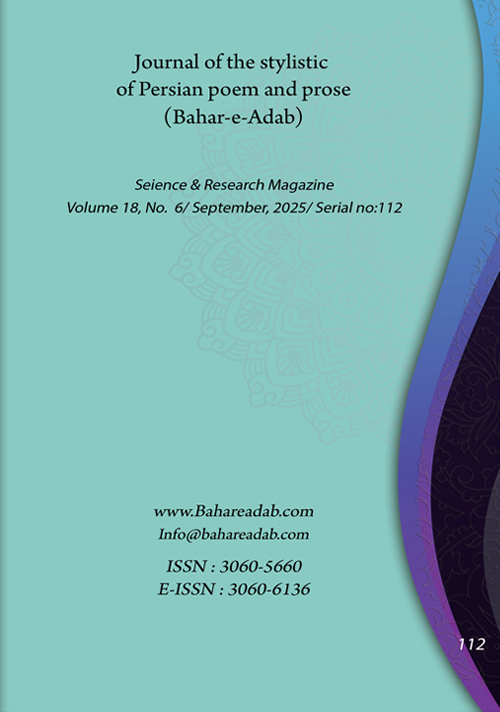- Count View : 40
- آدرس کوتاه شده مقاله: https://bahareadab.com/article_id/1870
- کد doi مقاله: Doi: 10.22034/bahareadab.2025 .18 .7897
Journal of the stylistic of Persian poem and prose
volume Number 18،
number In Volume 6،
،
issue Number 112
A comparative study of the theme of existence and nonexistence in the views of Rumi and Blake
Fereshteh Zare , Elham Khalili Jahromi (Author in Charge)
Abstract
BACKGROUND AND OBJECTIVES: Comparative literature in the realm of mysticism functions as a universal language that unites poets and thinkers from diverse cultural and geographical backgrounds under the canopy of a single, authentic tree. Mystical poets across cultures and ages transcend linguistic conventions, creating new imagery and themes grounded in intuition. Among these significant themes, which frequently recur in the works of major mystical literary figures, are the concepts of "being" and "non-being" terms that are relatively synonymous with existence and nothingness, transience and permanence, among others. Jalal al-Din Rumi and William Blake are two prominent mystical poets who lived nearly five centuries apart, each emerging from distinct cultural and geographical contexts. Although existing research indicates that Blake was not directly influenced by Rumi’s works, their shared mystical outlook led to comparable perspectives on the nature of reality and the quest for truth beyond the material world. Despite this conceptual affinity, their poetic styles and rhetorical expressions differ significantly.
METHODOLOGY: This study, therefore, conducts a comparative analysis of the concepts of "being" and "non-being" in William Blake’s The Marriage of Heaven and Hell and Rumi’s Divan-e Shams, examining their semantic and metaphorical dimensions and highlighting both the similarities and differences between the two poets.
FINDINGS: Rooted in the tradition of Islamic mysticism, Rumi envisions a mystical journey aimed at attaining ultimate truth through the dissolution of the individual ego and its union with the Divine Beloved. In contrast, Blake, working within the Christian mystical framework, employs a symbolic and often paradoxical language to affirm the preservation of creative individuality, the reconciliation of opposites, and the re-sacralization of the human self.
CONCLUSION: As demonstrated, both poets regard the perceptible world and the outward senses as veils that obscure inner vision and hinder the apprehension of truth. In Rumi’s mystical thought, liberation from these veils is realized through annihilation in divine love; in contrast, Blake’s vision manifests this liberation as the emergence of genius and the transcendence of sensory perception. Rumi’s conceptual metaphors of being and non-being are expansive and fluid: non-being may signify absolute existence, the unseen realm, or the Divine (such as Shams or God), while at other times it denotes the material world and its transient beings. Similarly, being may indicate true existence or, conversely, the ephemeral world and the ego-self. Thus, meaning fluctuates among synonymous, antithetical, and paradoxical dimensions. In contrast, Blake’s rhetorical mode is more structured and symbolic: by emphasizing oppositional imagery, he aims at reconciling polarities and awakening imaginative insight, primarily through the tension between spiritual reality and embodied material existence.
Keyword
being
, non-being
, existence
, nothingness
, transience
, permanence
, Rumi
, Blake
- The Holy Quran.
- Este’lami, M. (2019). An Encyclopedic Dictionary of Sufism and Mysticism. Tehran: Farhang-e Mo’aser, pp. 1317, 1475, 1807, 1821–1822
- Hafez, Shams al-Din Mohammad. (2020). Divan-e ghazals. Edited by Khalil Khatib Rahbar, with word meanings, explanations of difficult verses and sentences, and some grammatical and literary notes. Tehran: Safi Ali-Shah. p. 360
- Dehbashi, M. (2000). Analytical foundations of the theory of “contrast in being” in Rumi’s Masnavi. Journal of Faculty of Literature and Humanities, 16-17, pp. 11–36
- Zamani, K. (2024). Commentary of Divan-e Shams. Tehran: Shekooh Danesh & Elmi Publishing
- Ibn al-Arabi. (2008). Fusus al-Hikam. Edited and translated by Mohammad Khajavi. Tehran: Mola
- Baba Rukna (Rukn al-Din Mas'ud ibn Abdollah Shirazi). (1980). Sharh-e Fusus al-Hikam-e Muhyiddin Ibn Arabi. Edited by Rajabali Mazloumi, with an appended article by Jalal al-Din Homai. Tehran: Institute of Islamic Studies, McGill University
- Ziaei, Anwar. (2010). “The Contrast of Reason and Love in Rumi’s Masnavi and Hadiqa Sanai. Journal of Literary Aesthetics, 4, pp. 119–140
- Ghanbari, B. (2014). A Comparative Study of Buddhist Nirvana and the Concepts of Annihilation and Subsistence in Rumi's Thought. Information: Wisdom and Thought Journal, 12, pp. 22–27
- Moghaddam, S. (1998). Rumi and Blake: Two Kindred Spirits. Journal of Humanities, Alzahra University, 26–27, pp. 1–26
- Molavi Jalal al-Din Muhammad Rumi. (1997). The Complete Works of Shams Tabrizi (including a biography of Rumi by Badi' al-Zaman Foruzanfar, with an attached glossary of terms and expressions from the Divan of Shams). Tehran: Amir Kabir
- Molavi Jalal al-Din Muhammad Balkhi. (2020). Masnavi Ma’navi (Last revision by Reynold A. Nicholson with a new collation of the Konya manuscript; revised edition and translation by Hassan Lahooti). Tehran: Mirath-e Maktub
- Nasafi, Ezz al-Din. (n.d.). Al-Insan al-Kamel. (Trans. Unknown). P.101
- Nasafi, Ezz al-Din. (2022). Al-Insan al-Kamel (Trans. Zia al-Din Dehshiri). Tehran: Tahouri
- Blake, W. (2015). The Marriage of Heaven and Hell (O. Shams, Trans.). Paris Publishing. (Original work published 1790). P 21
- Blake, William. (1906). The Marriage of Heaven and Hell. Boston: John W. Luce and Company.
- Rix, R. W. (2016). All religions are one: A note on sources. Blake/An Illustrated Quarterly, 49(4).
- Ackroyd, Peter, Blake, First published in Great Britain by Sinclair Stevenson, 1995
- Wilson, Mona, The life of William Blake, London, Oxford University press, 1971

